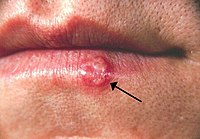
Photo from wikipedia
OBJECTIVE This study aims to evaluate the oxidative stress marker Malondialdehyde (MDA) in oral submucous fibrosis with available literature. MATERIALS AND METHODS We conducted a literature search electronically in PubMed… Click to show full abstract
OBJECTIVE This study aims to evaluate the oxidative stress marker Malondialdehyde (MDA) in oral submucous fibrosis with available literature. MATERIALS AND METHODS We conducted a literature search electronically in PubMed (MeSH), Science Direct, Scopus, and Google Scholar using specific keywords. RESULTS A systematic search in PubMed, Science Direct, and Google Scholar identified 334 articles. Of these, four were duplicate reports, and three were animal studies. After reading the abstracts of the collected articles, 288 articles were excluded for the following reasons: low quality, not relevant to the research question, or did not meet the inclusion criteria. The remaining 46 articles were chosen for full-text assessment. Finally, the present qualitative synthesis included 23 articles for evaluation. The selected studies in MDA analysis in a random-effects model showed higher heterogeneity (Q = 477.636, p < 0.001, I2 = 95.394%). The standard difference in mean MDA concentration between oral submucous fibrosis (OSMF) and healthy subjects was estimated as 2.73 nmol/mL (95% confidence interval: 2.08-3.38). CONCLUSION The selected studies showed significantly higher MDA levels in various biological samples of patients with OSMF. Therefore, further studies are needed to estimate oxidative stress levels by using different biomarkers in OSMF to direct future therapy.
Journal Title: European journal of dentistry
Year Published: 2021
Link to full text (if available)
Share on Social Media: Sign Up to like & get
recommendations!